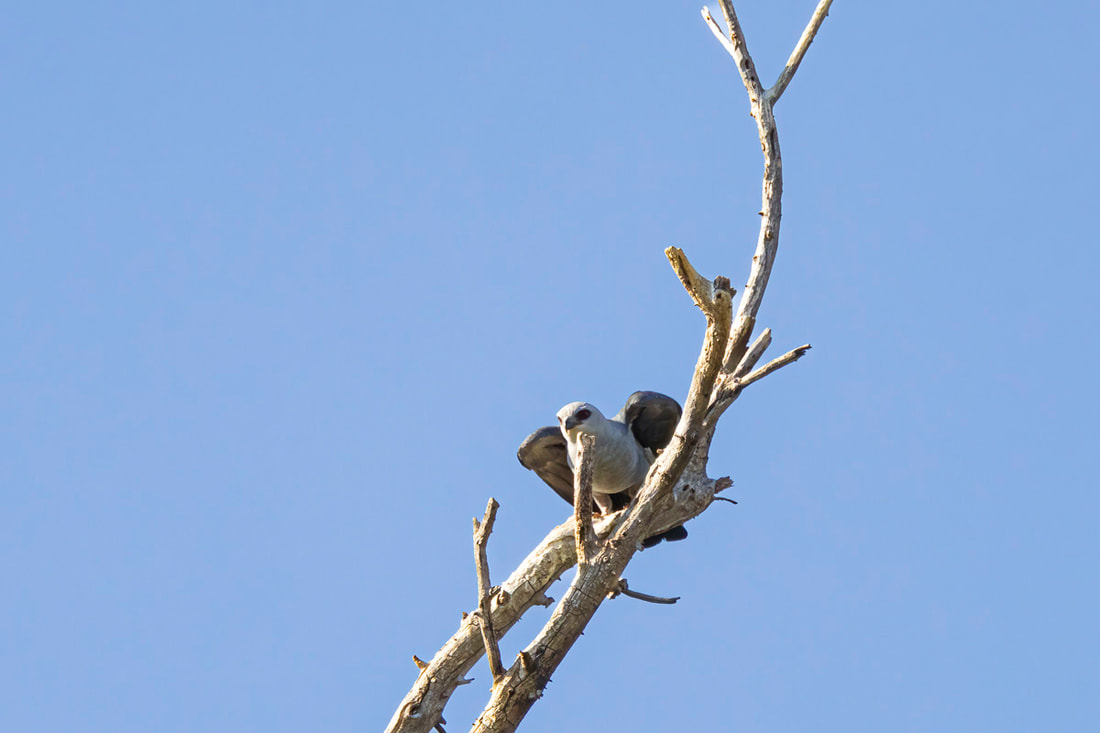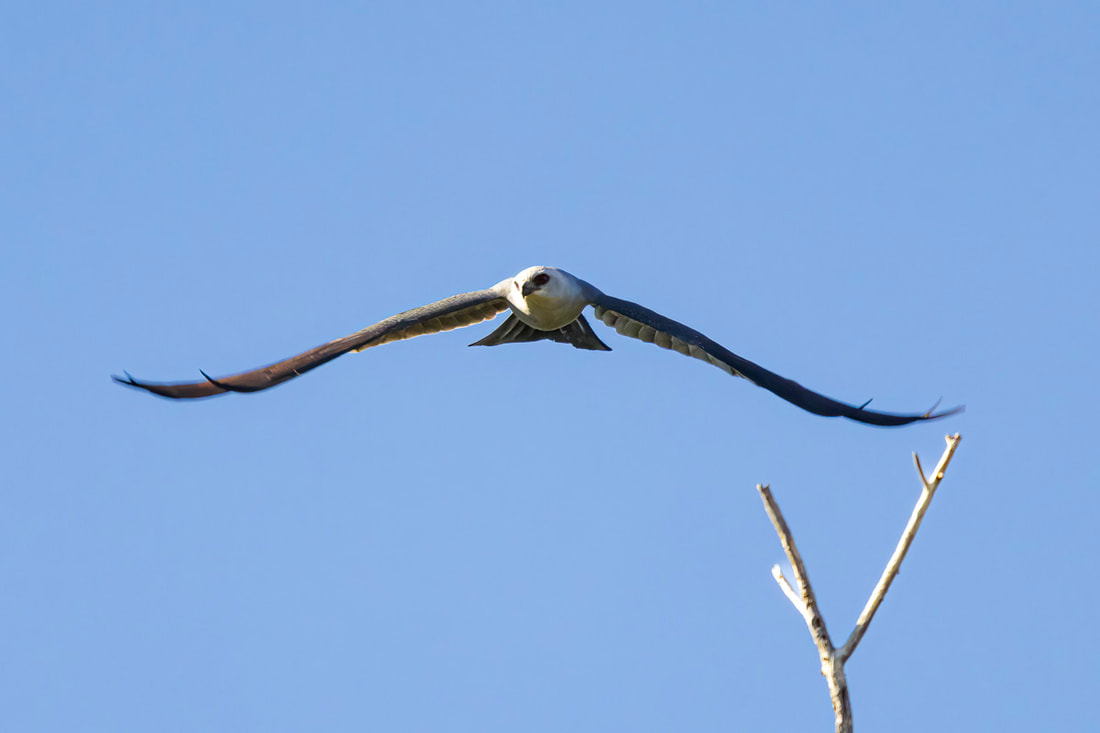|
Canon R7 RF 100-500mm with 1.4x Extender at 700 mm, f/10, 1/1600 sec, ISO 640, +2/3 EV. During the SW Wings Festival in August we took a day trip led by Homer Hansen to the Holy Trinity Monastery in St. David, Arizona. This post is focused on the Mississippi Kite, a raptor that breeds in that area each summer. The images here were captured on the monastery grounds where several of these kites were actively foraging for food. The Mississippi Kite is in the Order Accipitriformes, Family Accipitridae, along with other kites, eagles and hawks. They are common in the Americas, but relatively rare in SE Arizona.
The birds are known for defending their nests from intruders, often divebombing picnickers and golfers in urban/suburban areas. Mississippi Kites eat medium-sized and large insects, often caught on the fly, but will also eat frogs, toads, lizards, small box turtles, snakes, small birds, and mammals (Ref: Birds of the World). Images series below: A kite sits atop a high snag, likely looking for food, crouches and takes off, showing his/her* wing span. *The two sexes are very similar in appearance, overall length about 14 inches, with the female being larger and heavier. Among all raptors, the female is uniformly larger and heavier. Canon R7 RF 100-500mm with 1.4x Extender at 700 mm, f/10, 1/1000 sec, ISO 1000, +1 EV. Mississippi Kites are sleek, gray/black raptors with long pointed dark wings and a squared offed tail. Their bill is on the small size with a hooked tip. (Ref: All About Birds). During our morning at the monastery we saw several kites making sorties out from snags looking for insects. In the image that follows we see the full wing-span of the bird, my guess between 3 to 4 feet. The wing tips are sharply tapered. The birds are quite acrobatic in flight at lower altitude, but soar as well. In the series below, I was able to catch one of the kites with a large insect firmly held in the left talon while the right leg was retracted. Canon R7 RF 100-500mm with 1.4x Extender at 420 mm, f/8, 1/2000 sec, ISO 500, +2/3 EV. Mississippi Kites are known for eating their prey while on the wing. Below, this kite looks down, as though searching the ground, but in fact, is getting ready to take a nibble of his breakfast. Of note, another flying insect seems to be following the kite and his food. Below, jaws open, he gets ready to take a bite. Below, the flight continues, still trailed by another insect. Maybe it is safer to be behind a kite, rather than in front of it! In these later shots we can see the wing markings better. If all goes as planned, I am off to Panama in October, and I hope to see raptors migrating in numbers through Panama on their way to South America. October 14, 2023 Many thanks to Homer Hansen, not only for guiding our day in August, but for reviewing this post and adding some more information: "Wingspan of the Mississippi Kite averages right around 3 feet. The insect here looks like an adult Giant Mesquite Bug, and I wonder if an instar was with it and maybe falling off The underwing pattern suggests that this is a “subadult” bird (i.e. hatched in 2022) as it still retains some of the juvenile feathers from the preceding year. " Editor's note: instar is the term for one of many phases of immature Mesquite Bugs which molt progressively to become large adults. See the link for more details. That's all for now!
More soon . . . . Happy Trails!
6 Comments
Elizabeth Y. Koehler
9/24/2023 01:21:15 pm
Thank you for the great photos of the Mississippi Kite, Henry! Your comments are always much appreciated! Have a great trip to Panama!
Reply
Heidi B Harley
9/24/2023 03:20:05 pm
Never seen or learned about this bird before! Looks kind of falcon-esque with that small hooked bill. AMAZING photos with the bug in the talon -- looks maybe like a palo verde beetle?
Reply
9/24/2023 08:44:51 pm
Heidi, Thanks for the comment, and for the ID of the beetle. I looked it up, and I think you are correct. The Palo Verde Beetle is one of the biggest, up to 3 inches long, which seems about right based on the photo.
Reply
Deb
9/25/2023 10:03:34 am
I have to say Bravo to you! Capturing any wildlife behavior requires being there when it happens and this is when photographers “waiting” skills are tested. I’m so impressed with these action images. My impression from your first image was…I think he has Halloween red eyes. I wasn’t sure about that. Because you provide pathways for reference material, I learned they actually have red eyes. I learned a lot more, which became more identifiable from the gallery that followed in your post. Quite the calculated management and process this birds do in flight. I have more to say but….. the day must move on. Thank you again for sharing your experiences and the resource options you provide us so we can explore more for our own education. I’m looking forward to your Panama trip too…. hint-hint can we see photos of the feathers that you find there? Enjoy the time away.
Reply
9/25/2023 10:48:22 am
Deb, Thanks for the comments! Yes, I am sure there will be stories to tell when I get back, and of course, photos to go with them! More soon . . .
Reply
Leave a Reply. |
AuthorHenry Johnson, photographer and author of this site. For more detail, see About
Categories
All
Archives
July 2024
|



















 RSS Feed
RSS Feed